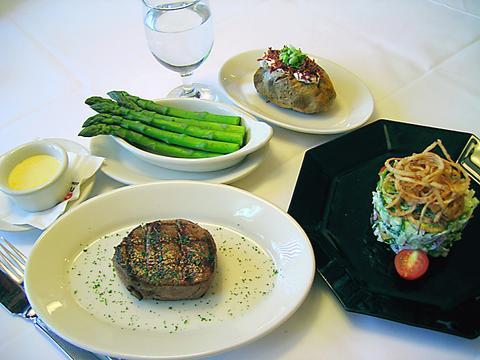If you're looking to impress or are simply in dire need of dining out in an establishment where the waiting staff are well trained and the food is above reproach, then you can't go far wrong with Ruth's Chris.
Founded in 1965 in New Orleans, the US chain's Taipei branch opened its doors in 1993. Over the past decade the restaurant has become the steak joint of choice for Taipei's more discerning diners.
The predominantly red wood furnishings and interior design gives the place a mature well-aged look -- something like a private gentlemen's club.

PHOTO: GAVIN PHIPPS, TAIPEI TIMES
In keeping with the restaurant's high-end appearance Ruth's Chris staff are always immaculately turned out and are well versed in both service techniques and the menu.
According to manager Joey Tseng (
The menu lists everything any steak aficionado could wish for and then some. All specially imported from the US, Ruth's Chris steaks include 8oz and 12oz fillets (NT$890/NT$1,290), 12oz and 16oz rib eyes (NT$1,190/NT$1,430) and New York strips (NT$1,230/NT$1,490) and the house special a behemoth 40oz Porterhouse NT$3,490.
The steak is prepared in the restaurant's oven, which reaches temperatures of 1,8000F and seals the meat to ensure none of the flavor escapes. The taste is superb and unmatched by any other steak restaurant in Taiwan. The meat literally melts in the mouth.
It's not only the steak that is imported. To guarantee diners a flavorsome meal the joint also imports its potatoes, mushrooms and broccoli. Side orders of potato include mashed, lyonnaise and sauteed. They range in price from NT$160 to NT$190 with other vegetables costing from NT$160 to NT$200 per dish.
For those with room to spare after chowing down on a truly great steak, desserts include the popular creme brulee NT$220, the hugely recommended apple crumb tart NT$220 and bread pudding with Jack Daniels sauce NT$190.
Along with offering good food Ruth's Chris also stocks a reasonable selection of fine wines and other aperitifs. The wine list includes over 100 new and old-world wines, many of which have been specially imported by the restaurant. The wine ranges in price per bottle from around NT$13,000 for rare vintages to NT$1,000 for more common bottles.
Sure, you pay more at Ruth's Chris, but the service is exceptional -- you never have to ask for anything twice -- and the food is faultless in both presentation and taste. More importantly for steak lovers, black pepper sauce is nowhere in sight. And pity the philistine who asks for A1 Steak Sauce at Ruth's Chris!

May 26 to June 1 When the Qing Dynasty first took control over many parts of Taiwan in 1684, it roughly continued the Kingdom of Tungning’s administrative borders (see below), setting up one prefecture and three counties. The actual area of control covered today’s Chiayi, Tainan and Kaohsiung. The administrative center was in Taiwan Prefecture, in today’s Tainan. But as Han settlement expanded and due to rebellions and other international incidents, the administrative units became more complex. By the time Taiwan became a province of the Qing in 1887, there were three prefectures, eleven counties, three subprefectures and one directly-administered prefecture, with

It’s an enormous dome of colorful glass, something between the Sistine Chapel and a Marc Chagall fresco. And yet, it’s just a subway station. Formosa Boulevard is the heart of Kaohsiung’s mass transit system. In metro terms, it’s modest: the only transfer station in a network with just two lines. But it’s a landmark nonetheless: a civic space that serves as much more than a point of transit. On a hot Sunday, the corridors and vast halls are filled with a market selling everything from second-hand clothes to toys and house decorations. It’s just one of the many events the station hosts,

Among Thailand’s Chinese Nationalist Party (KMT) villages, a certain rivalry exists between Arunothai, the largest of these villages, and Mae Salong, which is currently the most prosperous. Historically, the rivalry stems from a split in KMT military factions in the early 1960s, which divided command and opium territories after Chiang Kai-shek (蔣介石) cut off open support in 1961 due to international pressure (see part two, “The KMT opium lords of the Golden Triangle,” on May 20). But today this rivalry manifests as a different kind of split, with Arunothai leading a pro-China faction and Mae Salong staunchly aligned to Taiwan.

Two moves show Taichung Mayor Lu Shiow-yen (盧秀燕) is gunning for Chinese Nationalist Party (KMT) party chair and the 2028 presidential election. Technically, these are not yet “officially” official, but by the rules of Taiwan politics, she is now on the dance floor. Earlier this month Lu confirmed in an interview in Japan’s Nikkei that she was considering running for KMT chair. This is not new news, but according to reports from her camp she previously was still considering the case for and against running. By choosing a respected, international news outlet, she declared it to the world. While the outside world